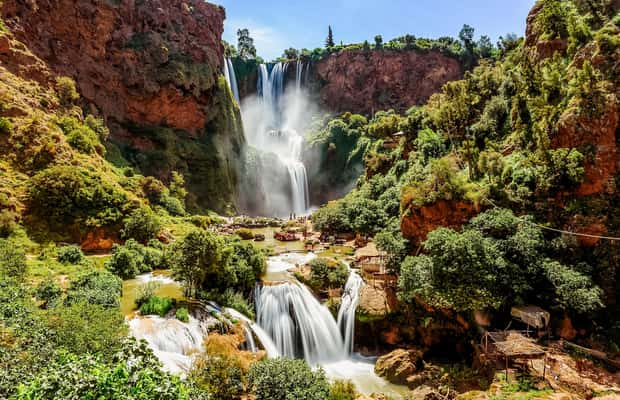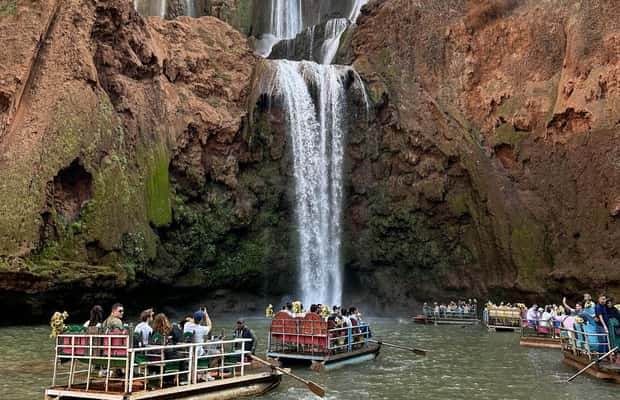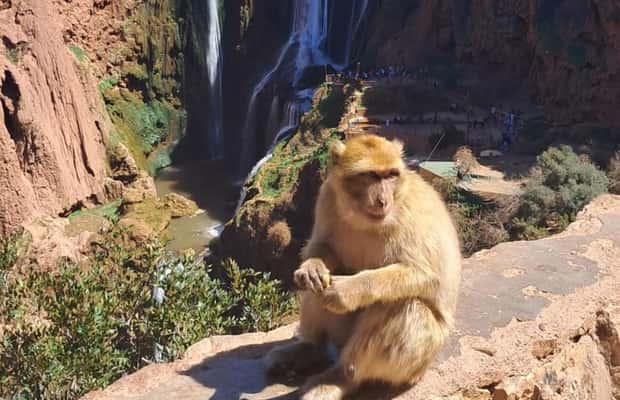Setting Off: Early Morning Departure from Marrakech
It was just after 7 a.m. when I zipped up my backpack, laced my walking shoes, and stepped out into the pinkish light of an early Marrakech morning. The dry air had that warm, slightly dusty smell unique to this city. The call to adventure stirred my spirit. I had been dreaming of visiting the Ouzoud Waterfalls for months, inspired by stories from locals, travel blogs, and breathtaking photos on Instagram. Finally, today was the day.
Getting to Ouzoud from Marrakech isn’t the simplest journey, especially for solo travelers or those new to Morocco. The waterfalls sit about 150 kilometers northeast, deep in the rugged Atlas Mountains. I booked a day trip through my riad’s concierge—one of those simple, hassle-free decisions you make to avoid the complex bus and taxi system. The tour cost me about €25 (around 270 MAD), including transport, a guide, and a boat ride under the falls.
The Drive: From Marrakech Medina to Olive Groves and Mountains
As our air-conditioned minibus pulled out of Marrakech, the city’s noise and bustle gradually faded. The route wound through olive groves, red earth, and small Berber villages nestled in the hills. I looked out the window at the changing landscape, from the dusty city outskirts to the lush greenery surrounding the falls.
The group on the minibus was a mix: a German couple eager to hike, a Spanish backpacker, and a friendly Moroccan family visiting for the weekend. Our guide Hassan entertained us with tales of the Atlas Mountains, Berber history, and local legends about the waterfalls. According to folklore, the name "Ouzoud" means "the act of grinding" in Berber, referring to the old olive mills found nearby.
Arrival in Tanaghmeilt: The Gateway Village
We arrived at the village of Tanaghmeilt, a humble settlement surrounded by olive trees and craggy cliffs. The air was noticeably fresher, scented with pine and earth. The only sounds were birdsong and the distant roar of the waterfalls. Here, life moved slower than in Marrakech; the pace was peaceful and welcoming.
Hassan handed us water bottles—“hydrate before you hike,” he reminded us with a grin. From here, it’s a roughly 20-minute walk down a well-marked path to the falls. The trail meanders past terraced olive groves, small food stalls selling fresh fruit and argan oil, and children playing soccer with makeshift balls.
Walking Among Olives and Local Life
The path is steep in parts but manageable, shaded by olive and almond trees. Along the way, local women sat weaving baskets or grinding argan nuts by hand, a craft dating back centuries. I stopped to watch them for a moment, fascinated by their skill and the aroma of crushed nuts in the air.
Further down, small cafés offered sweet mint tea and freshly baked bread. The friendliness of the locals was heartwarming. Several kids greeted us with shy smiles and occasional “Bonjour!” I bought some hand-pressed argan oil as a souvenir, one of those gifts that feels deeply connected to the land and its people.
First Glimpse: The Stunning Ouzoud Waterfalls
Then suddenly, the trail opened up and there it was—an endless curtain of rushing water, crashing over red rock cliffs into a vibrant green pool below. The falls drop over 110 meters in three cascading tiers, making them the highest in North Africa. The morning sun created misty rainbows that danced around the gorge.
Photographs don’t do it justice. The sheer power and beauty of the water combined with the lush vegetation made it feel like stepping into a hidden fairy tale. The air smelled fresh and damp, and the sound of the falls was constant—a deep, soothing roar that echoed through the valley.
Meeting the Barbary Macaques
As we walked closer, Barbary macaques began to appear in the trees. These curious monkeys are famous for their playful antics and sometimes cheeky behavior. I watched one snatch a snack from a vendor nearby, then pause and stare with big, expressive eyes. They’re wild but accustomed to humans, so it’s important to keep a respectful distance and not feed them.
The Boat Ride: Dancing in the Mist
At the base of the falls, local boatmen offered circular rafts decorated with colorful plastic flowers. For 20 MAD (about €2), I hopped on a raft that slowly pushed me right under the main cascade. The water spray soaked my clothes instantly, and the mist created a cool, refreshing veil in the heat of the day. Laughing tourists all around shared the joyful experience, faces bright with excitement.
The boat ride was playful and memorable—one of those moments when you feel fully alive and connected with nature.
Dining with a View: Moroccan Flavors at the Gorge
After drying off, I found a terrace restaurant perched on the edge of the gorge. The panoramic view of the falls was spectacular. The menu was filled with Moroccan staples: lamb tagine with prunes and almonds, vegetable couscous, fresh salads, and khobz bread.
I ordered the tagine, a classic slow-cooked dish bursting with sweet and savory flavors. The mint tea came in traditional glasses, fragrant and refreshing. Dining while watching the water thunder down was an unforgettable sensory experience.
Exploring Beyond the Falls: Quiet Corners and Local Swimmers
With some free time, I wandered upstream to quieter spots. Local families were swimming in calm pools, children splashing and laughing. The natural pools invite visitors to cool off in the summer months. I dipped my toes in, the water cool against the skin, and soaked in the serene atmosphere.
Choosing to Stay Overnight: A Different Perspective
While many tourists return to Marrakech the same day, I decided to stay overnight and explore the area more slowly. I booked a room at Riad Cascades d'Ouzoud, a cozy eco-lodge about 3 minutes’ walk from the falls. The price—640 MAD per night—felt like a bargain for a clean room with hot water and a terrace overlooking olive groves.
Ahmed, the owner, welcomed me warmly and shared stories about Berber traditions and local life. Sitting on the terrace that evening, watching the sun set behind the cliffs, was pure magic.
A Night Under the Stars: Peace and Nature
As night fell, I joined other travelers around a fire pit. We shared tajines and olives, laughter and stories. The stars shone brighter here than in the city, and the silence was only broken by crickets and the distant roar of the falls. It was a profound moment of connection with nature and humanity.



Sunrise Hike and Morning Reflections
The next morning, I woke early to birdsong and a soft, golden light spilling through the wooden shutters. After a breakfast of msemmen (Moroccan pancakes), honey, and strong coffee, I set out on a hike to a high viewpoint above the falls.
From this vantage point, the falls looked even more dramatic—the water snaking over red rocks into emerald pools below. Monkeys chattered in the trees, and a rainbow shimmered in the early light. I sat quietly for almost an hour, feeling grateful for this peaceful moment.
Heading Back: The Scenic Route Home
Instead of returning on the tour minibus, I opted for a slower, more local route back to Marrakech. A shared taxi took me to Azilal for 60 MAD, where I caught a CTM bus back to Marrakech (around 80 MAD). The journey was longer, nearly six hours, but it allowed me to see more of the Atlas foothills and reflect on my experience.
Best Time to Visit and Travel Tips
Planning your trip? The best time to visit Ouzoud is during spring (March-May) and autumn (September-October) when temperatures are mild and the falls are at their fullest. Summer can be hot but perfect for swimming in the pools below the falls. Winter is cooler and quieter but less green.
Avoid weekends if possible, as local tourists flock to Ouzoud, making the trails busier. Wear sturdy walking shoes, bring sunscreen, a hat, and a towel if you plan to get close to the water. Keep an eye on your belongings around the monkeys, and always follow guide instructions.
Recommended Tours and Booking Options
Many companies offer day trips from Marrakech, ranging from budget group tours to private excursions. I recommend reputable providers on platforms like GetYourGuide and Viator.
These tours often include: pickup and drop-off from your accommodation, a local guide, hiking the falls, a boat ride under the cascades, and sometimes lunch. Prices typically range from €25 to €45 per person.
Reading reviews on Tripadvisor helps choose the best fit for your style and budget.
Experiencing Moroccan Hospitality: Food and Culture
Food is part of the Ouzoud experience. From tagines rich with prunes, almonds, and spices, to fresh salads and crusty bread, every meal connects you with centuries of Moroccan tradition. Mint tea—sweet and cooling—is a constant companion, served everywhere from rustic stalls to riverside terraces.
Locals are proud of their culture and eager to share it, whether through crafts like argan oil production or simple conversations about Berber life in the Atlas Mountains.
Where to Stay Near Ouzoud Falls
If you want to extend your visit beyond a day, several guesthouses and lodges offer comfortable stays:
- Riad Cascades d'Ouzoud: Eco-friendly, authentic Berber hospitality, about 3 minutes from the falls, rooms from 650 MAD.
- Dar Rachid Ouzoud: Simple, budget-friendly accommodations near the village, offering home-cooked meals.
- Palais D'ouzoud: More upscale option with panoramic views and a swimming pool.
Booking in advance is recommended during peak season.
More Than a Waterfall: Why Ouzoud Captures the Heart
Ouzoud is more than just a spectacular waterfall. It’s a place where nature, culture, and community intertwine. It’s a chance to disconnect from city chaos and reconnect with something elemental—water, stone, trees, and the laughter of children playing in the river.
Traveling there taught me patience and appreciation for simple moments. Whether watching monkeys play in olive branches or sharing stories with other travelers around a fire, Ouzoud leaves a lasting imprint.
Additional Adventures Near Ouzoud
If you have more time, consider exploring nearby attractions:
- Imi n’Ifri Natural Bridge: A natural rock arch formation, perfect for a short hike and photos.
- Lake Bin el Ouidane: A peaceful mountain lake with options for kayaking and fishing.
- Atlas Mountains Villages: Visit traditional Berber villages to experience local crafts, markets, and hospitality.
These spots are reachable with a rental car or guided tours and complement the Ouzoud experience beautifully.
Useful Internal Links for Your Readers
While planning your Ouzoud adventure, don’t miss these guides on MarrakechInMorocco.com:

Camel Rides in the Palmeraie Oasis Marrakech
arrakech, the Red City, offers many unique and memorable experiences for travelers, and one of the most popular activities is a camel ride in the iconic Palmeraie Oasis. This guide covers everything you need to know for planning a camel tour in this stunning palm oasis, including prices, tour options, and location details.
Read moreFinal Thoughts: A Trip to Remember
Would I return to Ouzoud Falls? Without hesitation. It’s a place that surprises you with its natural beauty, warms you with its hospitality, and stays in your memory long after you leave. Whether as a day trip or a multi-day retreat, Ouzoud is a must-see for anyone visiting Morocco.
From the wild Barbary macaques to the cool splash of the boat ride, from the savory tagines to the tranquil starry nights, this journey captures the heart and soul of Moroccan adventure.
So pack your bags, lace your shoes, and set out to discover one of Morocco’s most enchanting treasures.
For a comprehensive and detailed guide to exploring Marrakech, be sure to check out our Marrakech Travel Guide: All You Need to Know . It covers everything from where to stay and what to eat, to the best activities and practical travel tips, making it the perfect companion for your trip to this vibrant city.








